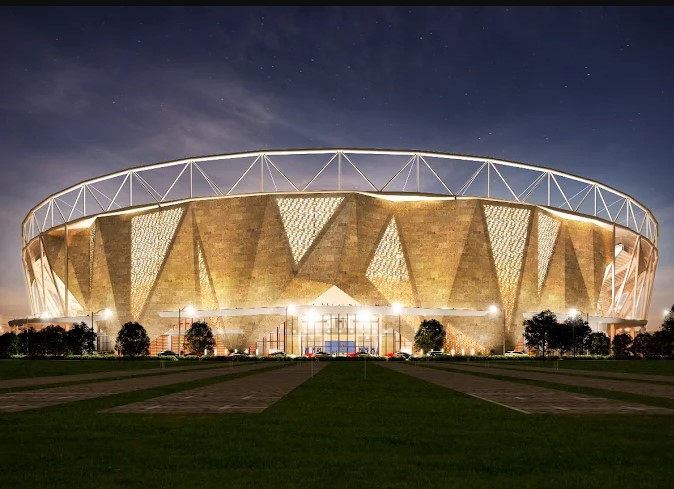The Narendra Modi Stadium, commonly known as the Motera Stadium, located in Ahmedabad, India, is one of the largest and most iconic cricket stadiums in the world. Since its renovation and expansion in 2020, it has been a marvel of modern sports architecture and a significant venue for international cricket. Apart from its massive seating capacity of over 132,000 spectators, another fascinating aspect of the stadium is the size of its playing field, especially the boundary lengths.
Table of Contents
Understanding boundary lengths is essential not only for players and coaches but also for fans and analysts. It affects scoring patterns, bowling strategies, and even player selection. This article provides a complete overview of the Motera Cricket Stadium’s boundary lengths, with detailed tables to highlight the dimensions and how they compare to other famous stadiums worldwide.
Introduction to Boundary Lengths in Cricket
In cricket, the boundary marks the edge of the playing field. When the ball crosses this boundary, it results in four or six runs depending on whether the ball touched the ground before crossing. Therefore, boundary length plays a crucial role in game dynamics. Longer boundaries typically favor bowlers and fielders by reducing scoring chances, while shorter boundaries can favor batsmen.
The Motera Stadium’s boundary lengths are unique because of the stadium’s sheer size. The ground has been designed to meet International Cricket Council (ICC) standards while accommodating an expansive playing area suitable for high-profile international matches.
Boundary Lengths at Narendra Modi Stadium (Motera)
The dimensions of the playing field at the Narendra Modi Stadium vary slightly around the ground, as is common with most cricket stadiums, but generally fall within specific ranges to conform to international standards. Below is a detailed table presenting the boundary lengths from various parts of the stadium:
| Boundary Direction | Minimum Length (meters) | Maximum Length (meters) | Average Length (meters) |
|---|---|---|---|
| Straight (Long-On) | 68 | 72 | 70 |
| Straight (Long-Off) | 68 | 72 | 70 |
| Mid-Wicket | 65 | 69 | 67 |
| Mid-On | 65 | 69 | 67 |
| Cover | 66 | 70 | 68 |
| Point | 66 | 70 | 68 |
| Extra Cover | 67 | 71 | 69 |
| Third Man | 67 | 71 | 69 |
Key Observations:
- The boundary lengths vary slightly due to the oval shape of the ground.
- The straight boundaries (long-on and long-off) are the longest parts of the ground, averaging around 70 meters.
- The mid-wicket and mid-on regions are a bit shorter, around 67 meters, creating strategic scoring zones for batsmen targeting those areas.
- The point and cover regions fall between 66 to 70 meters, making them moderately challenging for boundary shots.
Comparison with Other Major Cricket Stadiums
To appreciate the size of the Motera Stadium’s playing area, it helps to compare its boundary lengths with other iconic cricket grounds around the world:
| Stadium Name | Location | Average Boundary Length (meters) | Maximum Boundary Length (meters) |
|---|---|---|---|
| Narendra Modi Stadium (Motera) | Ahmedabad, India | 68-70 | 72 |
| Melbourne Cricket Ground (MCG) | Melbourne, Australia | 65-68 | 70 |
| Lord’s Cricket Ground | London, England | 63-66 | 68 |
| Eden Gardens | Kolkata, India | 65-67 | 70 |
| Newlands Stadium | Cape Town, South Africa | 64-67 | 70 |
Insights:
- The Motera Stadium ranks among the largest cricket grounds globally in terms of boundary lengths.
- Its boundaries are generally longer than those at Lord’s and Eden Gardens, making it a slightly tougher ground for hitting sixes.
- Comparatively, it is close to the Melbourne Cricket Ground (MCG), which is also known for its large playing area.
Impact of Boundary Lengths on Game Play at Motera
The expansive boundaries of the Motera Stadium influence the style of cricket played here:
- Batting Strategy: Batsmen need to rely more on timing and placement than brute power to clear the boundary. This promotes technically sound and intelligent batting.
- Bowling Strategy: Bowlers, especially spinners and pacers, can use the large boundaries to their advantage by bowling tight lines, making it harder for batsmen to score boundaries.
- Fielding: Fielders need to be exceptionally agile and have strong throwing arms to prevent quick singles from turning into twos or threes on such a large ground.
The stadium’s size also encourages more running between the wickets, making fitness and running skills crucial components for batsmen.
Unique Features Affecting Boundary Lengths
The Motera Stadium’s design includes several unique features that affect boundary lengths and overall gameplay:
- Oval Shape: Unlike traditional circular grounds, the oval shape means boundary lengths vary more significantly from different angles, adding strategic complexity.
- Pitch Orientation: The pitch is aligned in such a way that the longest boundaries are straight down the ground, a common design choice to maintain fairness.
- Ground Facilities and Placement: The stadium includes state-of-the-art facilities, and the boundary ropes are set to optimize spectator viewing without compromising playing conditions.
Summary Table of Motera Boundary Lengths
| Direction | Length (meters) | Notes |
|---|---|---|
| Long-On | 68 – 72 | Longest straight boundary |
| Long-Off | 68 – 72 | Longest straight boundary |
| Mid-Wicket | 65 – 69 | Shorter than straights |
| Mid-On | 65 – 69 | Shorter than straights |
| Cover | 66 – 70 | Moderate distance, good scoring zone |
| Point | 66 – 70 | Moderate distance, good scoring zone |
| Extra Cover | 67 – 71 | Slightly longer than cover/point |
| Third Man | 67 – 71 | Edge of the ground, challenging |
The Narendra Modi Stadium at Motera stands as a testament to modern cricket infrastructure, not only due to its seating capacity but also for its impressive playing field dimensions. The boundary lengths at Motera make it a challenging yet thrilling ground for both batsmen and bowlers. With slightly longer boundaries compared to many other international venues, it requires skillful batting and strategic bowling.
Understanding these boundary lengths helps fans and players alike appreciate the nuances of cricket played in this magnificent stadium. Whether it’s an IPL match or a high-stakes international test, the size of the Motera Stadium’s boundaries always adds an extra layer of excitement and strategy to the game.


